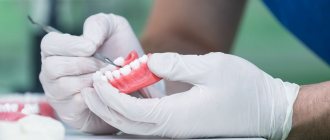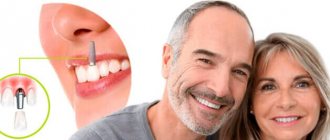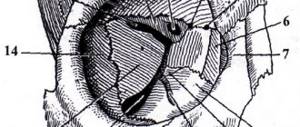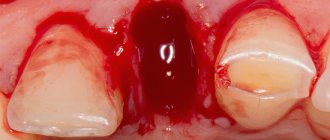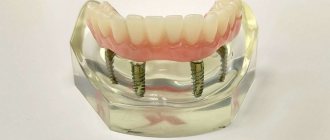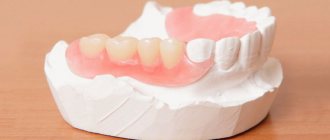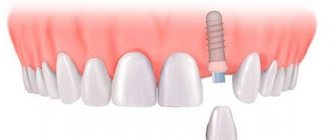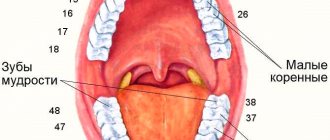Application of a partial removable laminar denture
Before placing a prosthesis in the oral cavity, the doctor must carefully examine it and ensure the high quality of finishing, grinding and polishing. It is especially necessary to carefully evaluate the edges of the base, which should not be sharp, have a rounded shape and the required thickness. Often, when modeling the labial surface of the base, it is artificially thinned, which subsequently complicates its correction, especially in the area of bone protrusions on the labial surface of the alveolar part of the jaw or in places where it adjoins the supporting teeth. The edge of the base facing the soft palate, on the contrary, should be thinned by the outer part of the base for its smooth transition into the mucous membrane of the vault of the palate. The thick, abruptly ending posterior edge of the base is, as a rule, poorly tolerated by patients due to difficult adaptation to this area of the prosthesis. The long edge, located outside the hard palate, also causes unpleasant sensations, especially when the soft palate oscillates, rising above the base. The gap that appears in this place is filled with food, which also causes additional discomfort when using the prosthesis.
You should carefully examine the areas of the base adjacent to the supporting teeth. The layer of plastic covering the body of the clasp will indicate its correct position in relation to the abutment tooth. If the clasp body gets into the undercut area, which will manifest itself primarily in the absence of plastic in this place or the presence of only a small film of it covering the metal, it will interfere with the application of the finished prosthesis.
The surface of the base facing the mucous membrane of the prosthetic bed must have its exact imprint. Defects that appear in the form of distortion of the relief of the base, thickening or growth can be the result of both damage to the surface of the working plaster model itself, and various kinds of defects in the plaster of the wax model of the prosthesis in the ditch or the molding of the plastic dough.
Finally, when examining the finished prosthesis, you need to pay attention to the quality of polishing of its parts - the base, artificial teeth and clasps.
After treating the denture with alcohol and rinsing it in water, proceed to placing it in the oral cavity.
A finished partial removable laminar denture is rarely placed on the denture bed without any obstruction. The presence of undercuts on natural teeth, the non-parallel arrangement of the teeth remaining in the oral cavity, or their displacement due to the loss of adjacent or antagonistic teeth make it difficult to apply a prosthesis. In this regard, the first attempt to install a prosthesis on the jaw should be made very carefully, without much effort, firstly, so as not to cause pain to the patient, and, secondly, so as not to cause the prosthesis to forcefully slip into its bed. In the latter case, the prosthesis overcomes the undercut zones due to the mobility of the teeth with a well-chosen path of insertion of the prosthesis. It will be quite difficult to remove the prosthesis, since it will be impossible to repeat the randomly guessed path of its application. This will require additional effort, which may cause pain. To avoid such a mistake, you should use carbon paper, which is placed under the prosthesis and try to put it together with it until an obstacle appears. Then the prosthesis is removed and carefully examined. The appearance of carbon paper prints on the inner surface of the base in the places where it adjoins the teeth remaining in the oral cavity will show areas that prevent the application of the prosthesis. To completely apply the prosthesis, a similar check is done several times until it takes its place on the jaw.
When sanding off areas of the base that interfere with the application of the prosthesis, you should also be careful. Burs and shaped carborundum heads should be selected according to the shape of the area that is being ground. By removing the plastic in small layers, it is possible to maintain contact between the base and natural teeth. Unjustified radicalism when performing this manipulation, as a rule, leads to the appearance of a gap between the teeth and the base.
The most common cause of difficulty in applying a prosthesis is plastic that gets into the undercut area of the supporting teeth. As already noted, inaccurate placement of the clasp body in this area may lead to the need to grind off its part that interferes with the application of the prosthesis. This in turn leads to a weakening of the mechanical strength of the clasp, and subsequently to its breakage.
Attention should be paid to the possibility of a gap appearing between the base of the prosthesis and natural teeth, not only due to careless fitting of the finished prosthesis. This may be a consequence of damage to the plaster model or the breaking off of plaster teeth before making the base. Inaccurate gluing of them will lead to significant problems when applying the finished prosthesis.
When assessing the accuracy of application of the finished prosthesis, it is necessary to establish the tightness of the base to the mucous membrane of the prosthetic bed, the lack of balancing and the accuracy of the position of the fixing elements. Only if the conditions are met can the prosthesis be recognized as fully applied. If one of them is not completed, it is necessary to continue fitting the prosthesis or try to find out the reason for its difficult application.
Balancing of the finished prosthesis can be a consequence of poor fit of the base, displacement of the fixing elements in the base when making it from plastic, damage to the plaster model (fracture of teeth or alveolar part of the jaw), deformation of the impression or model when casting it from plaster, deformation of the impression before casting the model (shrinkage impression material, damage to the impression when removing it from the oral cavity).
After making sure that the prosthesis is placed accurately, you should proceed to evaluating the fixing elements. At the same time, the position of the clasps on the supporting teeth, their tightness to the tooth surface and their fixing properties are checked. In addition, it is useful to pay attention to the aesthetic qualities of the clasps - whether the arms of the clasp open when you smile and in what part of the crown of the supporting tooth they are located. Careless manufacturing of the clasp or its displacement in the base when molding the plastic dough leads to its displacement on the supporting tooth, which significantly reduces its aesthetic properties.
The next step in applying a partial removable lamellar denture is to check the occlusal relationships. First of all, occlusal contacts of artificial teeth with antagonists in the position of central occlusion are studied. As noted earlier, after control pressing of the plastic dough in a cuvette during the manufacture of a plastic base, its thickness increases by a layer of plastic film remaining between the parts of the cuvette. In this regard, displacement of artificial teeth occurs. That is why, when applying a finished prosthesis, as a rule, there is a slight increase in the interalveolar distance. Using carbon paper, areas of premature occlusal contacts are identified. The occlusal surfaces of artificial teeth are ground down in such a way as not to disturb their anatomical shape. For this purpose, special metal cutters and shaped heads are used, which have a small diameter of the cutting surface and whose shape coincides with the relief area of the occlusal surface to be ground down. This allows you to prevent grinding down of excess plastic and causing separation of the teeth.
After correcting the closure of the teeth in the position of central occlusion, they proceed to refine it in other occlusions - anterior and lateral. For this they also use carbon paper, but the patient is asked to make chewing movements. The nature of occlusal contacts is studied using carbon paper prints on artificial teeth, and grinding is carried out according to the same rules as for central occlusion.
Lastly, the aesthetic qualities of the prosthesis are assessed: the correspondence of artificial teeth to natural ones, their position, anatomical shape and color, the appearance of the patient’s face with closed dentition at rest and when smiling. If the prosthesis meets all the requirements, the patient is given instructions on the rules for using prostheses and is invited to the next appointment to assess the quality of the prosthesis and the immediate reaction of the tissues of the prosthetic bed.
The term Adaptatio (lat.) - adjustment, adaptation. Orthopedic treatment is a serious intervention in the human body, one of the main problems of which is the patient’s adaptation to the prosthesis. The study of autonomic vascular reactions in patients during the process of adaptation to complete prostheses led to the conclusion that such an intervention, such as prosthetics, has an extraordinary impact on the body. No matter how well the prosthesis is made in accordance with all the rules, the main factor determining the success of mastering the prosthesis and getting used to it will be biological. The biological factor is understood as the sum of all manifestations of the body’s reactions to the prosthesis. Of great importance in the patient’s adaptation to prostheses are his correct psychological preparation and his awareness of the need to use a prosthesis as a therapeutic agent aimed at preserving his health. To do this, throughout the entire period of orthopedic treatment, the patient should be gradually and systematically informed about all the features of complete removable dentures, the fundamental difference between artificial teeth and natural teeth, and the role of the patient himself in the success of orthopedic treatment. He should know that the effectiveness of prosthetics depends not only on the quality of the prostheses themselves, but also on the patient’s patience and his desire to overcome them, that is, the patient’s psychological mood plays a very important role. The patient's aesthetic satisfaction with prostheses greatly contributes to his adaptation. And, conversely, even ordinary human prejudice plays a negative role in the creation of new or lost conditioned reflexes.
Adaptation to prostheses is a complex neuro-reflex process. There are three phases of adaptation according to Kurlyandsky V.Yu.:
1. Irritation phase (1 day);
2. Phase of partial inhibition of irritation (1-5 days);
3. Phase of complete inhibition (5-33 days).
Speech adaptation is of no small importance.
After applying the prosthesis, the patient is scheduled to see a doctor in the next 3 days, then once a week and then as indicated. The doctor continues observation until he is sure that adaptation to the prosthesis has occurred. This is what E.I. Gavrilov (1978) calls the principle of completeness of treatment.
Removing and applying complete dentures does not cause any particular difficulties, but here, too, the sequence should be observed, putting on the lower denture first and then the upper denture. Removal is carried out in the reverse order. Removing the upper prosthesis may cause some difficulties. To do this, with your mouth slightly open, place a cotton swab moistened with water under your upper lip in the area of the labial frenulum and squeeze it out so that drops of water fall between the edge of the denture and the gum. After this, the prosthesis is easily removed from the mouth.
The moment of onset of adaptation to prostheses can be considered as a manifestation of cortical inhibition, which occurs at different times depending on many reasons, ranging from 10 to 30 days. The timing of a patient’s adaptation to prostheses is influenced by the degree of fixation and stabilization, the presence or absence of pain.
Anyone who receives a complete removable denture is recommended to drink hot tea or coffee with candy or sugar immediately after applying it. This causes softening and loosening of the oral mucosa and, as it were, allows the edges of the prosthesis to sink deeper into it. In turn, the mucous membrane, tightly covering the edges of the prosthesis and adhering to them, contributes to a more stable fixation of the prosthesis. This is not necessary for partial dentures.
During the first day, food should be taken more softened, preferably pureed, and then it is recommended to switch to a regular diet. However, you should still avoid eating solid foods, such as dry bread crusts, crackers, sugar, nuts, etc. After eating, dentures should be removed and washed, and the mouth should be rinsed.
To restore impaired diction, it is recommended to talk and read aloud more. To quickly master the dentures and get used to them during the first 5-7 days, it is better to leave the dentures in the mouth overnight, but before going to bed, be sure to clean and rinse them, and repeat the same thing in the morning.
Tasks for self-control and self-correction of initial level of knowledge
Patient K., after applying and using a partial removable lamellar denture, notes that he began to chew food well, the pain in the masticatory muscles disappeared, and there is no sensation of the denture as a foreign body. Indicate the phase of adaptation to the prosthesis according to V.Yu. Kurlyandsky
Irritations
Fit and apply the prosthesis.
- He carefully examines the prosthesis from all sides. Looks for sharp edges, protrusions, roughness on the inside of the prosthesis (The inside is the side that lies on the mucous membrane. The outside faces into the oral cavity). If flaws are found, the doctor immediately cuts them off with a cutter (Plastic is always processed with a cutter).
The doctor looks at the quality of the prosthesis. Is there any porosity (gas, granular, compression porosity, remember?). Is it well polished? Are your teeth aligned correctly?
- When the doctor is sure that everything is in order, he disinfects the prosthesis. And puts it on the patient’s jaw.
- The prosthesis should be easy to put on. In the upper jaw, it may be hampered by excessively large maxillary cusps. On the lower side there are undercuts in the retromalar area, on the lingual side. Then the doctor grinds off the base on this side. First on one side (left or right). If it doesn't help, then do both.
Grind off where number 3 is - When the doctor places the prosthesis on the jaw, he checks how well it holds. The doctor presses his finger on the front and side teeth. The prosthesis should not come off. The doctor checks the fixation of the back of the prosthesis by pressing his finger on the front teeth, pushing them towards the lips. The front part - pulling the incisors down or up - depends on the jaw. The stability of the prosthesis is checked in motion. No, the patient is not forced to run. Just move the lower jaw in different directions.
- The practitioner checks for balanced occlusion. He must correct what the technician was not able to fully create. Using occlusal paper (carbon paper), the doctor checks uniform interdental contacts. If they are not there, the doctor selectively grinds the teeth with a small milling cutter, trying to preserve the anatomical shape of the teeth. Until you achieve perfect occlusion.
- The doctor checks the boundaries of the prosthesis using Herbst tests (They were described in the article about taking impressions). The point is that with certain movements, the necessary muscles at the border of the prosthesis tense. And if something is wrong, the prosthesis will be reset. Although it holds up well in a relaxed mouth.
When checking, the doctor may find errors that he had not noticed before. Either he was a fool, or the technician made a mistake, who will figure it out now. In any case, we looked at some errors here. And we don’t want to repeat them. Anyone interested will read it. There were only three types of errors left that were not considered. This is a shortening of the borders of the prosthesis and shortening on the side of line A. And balancing.
